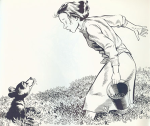What Fruit Can Teach Us or Learning Plot From Picture Books
I’ve tried to write picture books. Novels are easier.
Even if I can’t write them, I have learned a lot about structure and plot from good picture books. BLUEBERRIES FOR SAL, one of my all time favorites, is an excellent case in point.

We all know plot is what happens in a story.
The overused but effective example is:
The Queen died, then the King died, are two events.
The Queen died, then the King died of a broken heart, is a plot. Really, it’s a story, but that’s another post.
The reason BLUEBERRIES FOR SAL by the wonderful Robert McCloskey is worth a close look is that he braids two simple linear plots together, and the symmetry and synergy of the two storylines results in a much stronger, more emotionally satisfying story. A classic, in fact.
Strand One: We’ve got Sal and her mother, kind of a character unit. They want super-food blueberries. On a deeper level, naturally, they want safety and freedom from being eaten by bears. They also want to stay together as a unit.
So Mother and Sal are happily picking blueberries to can for the winter. There is humor as Sal eats all she picks.
Strand Two is introduced: We’ve got Little Bear and his mother. They also want blueberries. They also hope to avoid conflict with humans, and stick together. Tension is raised slightly by the mere introduction of the bears, even though they seem perfectly nice and anthropomorphic, and are happily stuffing themselves with blueberries to get fat for the winter. They are bears, after all, and will eat ANYTHING. Check out Margo Lanagan’s TENDER MORSELS if you like bear stories. It’s the YA version of the Grimm Brothers' Fairy tale, Snow White and Rose Red.


Back to blueberries.
Tension is raised, again when we switch back to Strand One--
Little Sal can’t find mom! She sets off to look for her and finds some crows. Finally she finds…Little Bear’s Mom. Ack!
Leaving Strand One at a cliffhanging spot, we switch to Strand Two of the BFS plot braid:
Little Bear also realizes he can’t find Mom. He sets off to find her, sees some partridges, and then finds… Little Sal’s Mom!
This is the climax!
This point of highest tension is wonderfully illustrated by McCloskey with a bird’s eye shot of Blueberry Hill, and Little Sal and Little Bear on either side of the hill, trailing along behind the WRONG MOM.
Everyone’s world is upset. The plot strands have crossed—and tangled. This is what happens if you don’t listen.
Back to Strand One: Little Bear’s mother realizes Little Sal is not her child (sic), and “walked off very fast to hunt for Little Bear.”
Strand Two: It takes Little Sal’s mother a couple of pages, and having some of the berries stolen out of her pail in her hand by Little Bear, before she realizes Little Bear is not her child. She also walked away quickly to look for Little Sal.
This IS a picture book so there’s no harm done. Their worlds collide in a gentle, humorous, and only slightly scary way (ah, but I can't shake the thought of Margo Lanagan getting a hold of this plot…). It’s worth noting that it’s the parents who are alarmed. Both Little Sal and Little Bear seem pretty nonplussed with the switch.
For the resolution, each parent finds their proper offspring. Then in another bird’s eye view of Blueberry Hill, everyone goes home with their own family, and all the blueberries they’ve obtained, happy, and perhaps a little wiser about not wandering off from each other.
Simple, right? Fine, you try it and see how simple it is. Lovable characters in balanced, twin plots intertwined to produce, humor, tension, climax and satisfying resolution.
BLUEBERRIES FOR SAL is simple, like DNA is simple. It’s an elegant double helix of story, brilliant and classic, that has much to teach any story creator.
